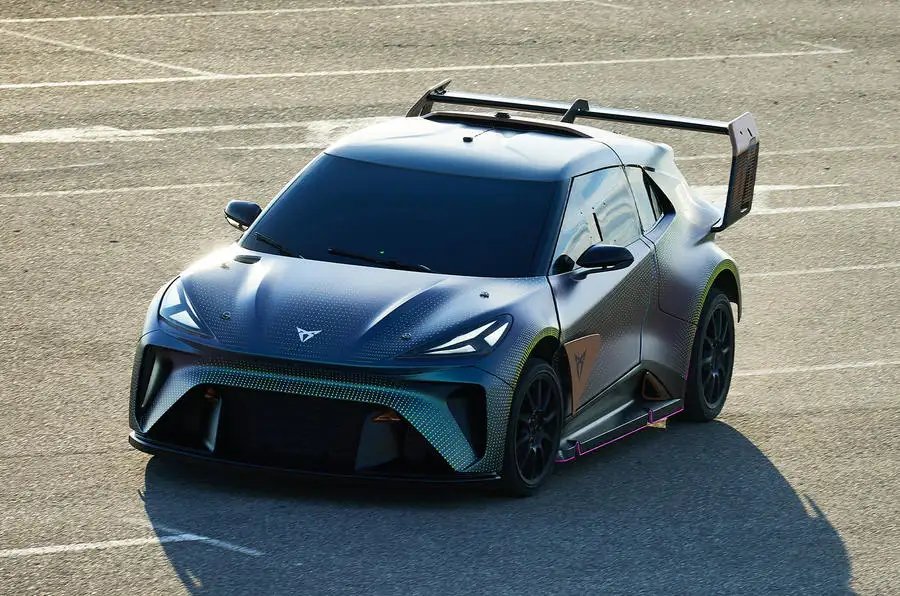Cupra’s new Exponential Experience – which allows people to drive a real electric racing car around a digital course seen using virtual reality (VR) goggles – has “huge potential to do things that nobody has done before” in both real and virtual motorsport, and elsewhere.
That’s according to former World Touring Car Championship racer Jordi Gené, who helped Cupra’s motorsport division develop the ‘phygital’ – merging physical and digital – system.
The Exponential Experience is built around the 430bhp Urban Rebel concept, which previews the forthcoming 2025 entry-level Raval hatchback but is in effect a purpose-built electric racing car.
While it can be driven normally, the car is also fitted with a VR headset, which then projects a digital reconstruction of a Barcelona street circuit into the driver’s vision.
It uses what Cupra calls a ‘reality loop’ system, so drivers can run over boost tokens on the digital track to give the car a real-world power boost.
Geofencing is used to ensure the car remains safe when the driver is unable to see the real world, and a co-driver is also able to stop the car.
Cupra has developed the concept in response to the rising popularity of gaming culture, with the idea that it serves as a potential way to merge real and digital motorsport in future.
Gené said a key development focus was on ensuring the virtual world was synchronised with the real-world sensations the driver experiences.
He said: “Normally when you use a simulator to test or learn a circuit, you know you’re in a simulator because your body isn’t moving properly. But with this, when you push, the car will slide for real, and the sensations are real. So you can learn a track with the real experiences.
“Nobody has put a proper simulator inside a racing car before. So the potential of it is as big as you can imagine. We could have one car physically racing on a circuit in Barcelona, taking on someone else who is racing on the same circuit somewhere else.”
Gené added that the tech is still under development and the team is working on a system that will produce real-world physical feedback when there is virtual contact between cars on the digital track.
Another key focus has been on minimising the lag time between translating physical inputs to the car into a response in the digital footage – the maximum delay has now been reduced to three-hundredths of a second.
“Any more delay than that and the lag means you’d feel sick,” said Gené.
Cupra has yet to determine long-term plans for the system, but Gené believes it could be used for racing drivers to really learn circuits, to stage races between people in different locations and to ease the transition of virtual racers into real motorsport.
He added: “When we saw the potential of it is when we started saying ‘okay, we need people with a lot of imagination’. If we just want to go racing on a normal circuit with this, there’s no point.
But with the goggles, you can have any circuit anywhere in the world – and you can add extra toys and benefits you can’t get in the real world. This is a great way to bring two worlds of motorsport together.”
New reality or virtual insanity?
The most unsettling moment of the Cupra Exponential Experience comes when you first step into the Urban Rebel.
It’s a familiar racing car environment, with a minimal dash, a purposeful roll-cage and tight bucket seats into which a helpful Cupra mechanic implants you by yanking on a six-point harness seatbelt. But then the mechanic straps a set of VR goggles to your head. At first, the goggles allow you to see the real world – in this case, an empty long-stay car park at Girona airport.
But imposed on it is a virtual gate that marks the start of the course. Trying to drive towards it while adjusting to the Urban Rebel’s stiff competition throttle and brakes is truly disconcerting.
Then you reach the gate, and suddenly reality fades from view and all you can see is Cupra’s virtual world: in this case, a tight street circuit laid out on a stylised virtual version of Barcelona. It’s like something straight out of Mario Kart Tour.
Weirdly, it’s so consuming that even though I’m driving a real car, I quickly forget that I can’t see where I’m driving it in the real world.
On my two warm-up laps, Jordi Gené, strapped into the passenger seat to act as both guide and emergency brake, suggests I slow down to take in some of the views, such as a virtual Sagrada Familia. It’s unclear whether he’s just keen to show off the hard work of Cupra’s development team or if this is a conceit to keep my speeds down.
When my timed runs start, more Mario Kart elements kick in: power-ups on the course give me extra boost, there’s a racing line to follow on the road and the course changes substantially halfway through my run.
It’s not unsettling at all: the real-world feel you get from the Urban Rebel is a real boost when lapping this virtual circuit.
Was I fast? Unknown. It certainly felt it when the VR goggles were down, although the tight nature of the track meant I never got to exploit much of the Urban Rebel’s power. Certainly, when watching other people tackle the experience later, it’s notable just how slowly they were guiding the Urban Rebel around the car park.
Ultimately, the Exponential Experience is a truly unusual one – albeit one that is, in all honesty, far less gimmicky than you’d expect. Merging the real and virtual motorsport worlds might sound like a bad idea, but it actually has real potential.
Related News

